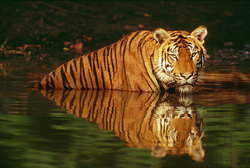Climate change threatens to wipe out one of world’s largest tiger populations this century
Washington, DC (Vocus/PRWEB ) January 20, 2010 — One of the world’s largest tiger populations could disappear by the end of this century as rising sea levels caused by climate change destroy their habitat along the coast of Bangladesh in an area known as the Sundarbans, according to a new World Wildlife Fund-led study published in the journal Climatic Change. Tigers are among the world’s most threatened species, with only an estimated 3,200 remaining in the wild. WWF officials said the threats facing these Bengal tigers and other iconic species around the world highlight the need for urgent international action to reduce greenhouse gas emissions. “If we don’t take steps to address the impacts of climate change on the Sundarbans, the only way its tigers will survive this century is with scuba gear,” said Colby Loucks, WWF’s deputy director of conservation science and the lead author of the study Sea Level Rise and Tigers: Predicted Impacts to Bangladesh’s Sundarbans Mangroves. “Tigers are a highly adaptable species, thriving from the snowy forests of Russia to the tropical forests of Indonesia. The projected sea level rise in the Sundarbans will likely outpace the tiger’s ability to adapt.” According to the study, an expected sea level rise of 11 inches above 2000 levels may cause the remaining tiger habitat in the Sundarbans to decline by 96 percent, pushing the total population to fewer than 20 breeding tigers. Unless immediate action is taken, the Sundarbans, its wildlife and the natural resources that sustain millions of people may disappear within 50 to 90 years, the study said. “The mangrove forest of the Bengal tiger now joins the sea-ice of the polar bear as one of the habitats most immediately threatened as global temperatures rise during the course of this century,” said Keya Chatterjee, acting director of WWF’s climate change program. “To avert an ecological catastrophe on a much larger scale, we must sharply reduce greenhouse gas emissions and prepare for the impacts of climate change we fail to avoid. In 2010, the Chinese Year of the Tiger, there is no better time for the US to pass domestic climate legislation and to reach an effective international agreement.” …
Climate Change Threatens To Wipe Out One of World’s Largest Tiger Populations This Century

I have always tried to make my kids aware of environmental issues and explain how we must all do our bit to reduce our carbon footprint, but seeing as the eldest is just 12 (the youngest 4) I have often wondered if I am really getting through to them (after all they are the Xbox generation…) Something that has really struck home with them recently is when I was explaining to them about animals becoming extinct as a result of our actions, there was a really moving special feature about polar bears in their [URL="http://www.discoveryboxbooks.com"]DiscoveryBox book[/URL] this month, and I would really encourage this approach from introducing kids to becoming greener little munchkins. My eldest really wants to help out with this cause now and "take action" for the sake of the polar bears. An issue close to my heart and I think we have had a break through. Also, in the World section, we learnt all about Nunavut! x